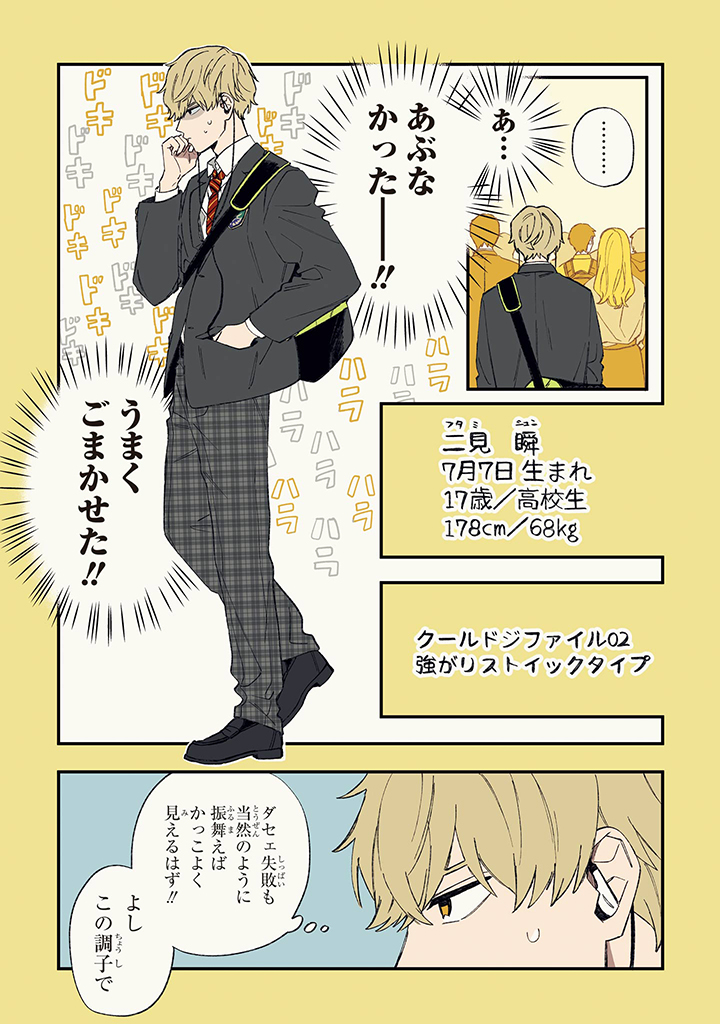フルカラーでもゴチャつかないコツは?『クールドジ男子』著者に「色塗りのあれこれ」を聞いた

構成/原田イチボ@HEW
5周年を迎えた「ガンガンpixiv」にて連載中の『クールドジ男子』は、ドジさえクールにキマる(!?)個性豊かな男子たちを描いたコメディマンガです。「コンビニのレジで商品と間違えて財布を出す」といったドジあるあるなネタや、キャラそれぞれの人間模様が人気を集めて、既刊4巻で50万部突破というヒットを飛ばしています。

「がっつりストーリーも描きたくて」現在の形式になった
── 「自動ドアだと思い込んで、手動ドアの前に立ち続ける」や「カフェで『アイスコーヒーのホット』と注文してしまう」など、『クールドジ男子』では、ドジなら誰でも共感できるような描写が満載です。ドジネタはどのように集めているんですか?

── 那多先生ご自身もドジなタイプなのでしょうか……!?

── Twitterでの投稿をきっかけに連載に繋がったんですよね。

── 「クールドジな男子のコメディ」と聞くと、あるある系のショートギャグを想像する人が多いでしょうが、『クールドジ男子』は、キャラそれぞれの変化や成長を楽しめるストーリーも魅力ですね。


19ページぶんの塗りなら、1日あれば十分
── フルカラーでの連載というのは、どのように決まったのでしょうか?

── 名残にしては、かなり手間のかかる形式じゃないですか!?

── どのようなペースで作業していますか?

── 何か塗りの時短テクニックのようなものはありますか?



── すごすぎる!

影無しベタ塗りでもキレイに見せるためのポイント
── 「型」とは?

── ということは、初期段階ではかなり試行錯誤を重ねたのでは?





── 影無しベタ塗りは、一歩間違えると、いかにも手抜きっぽかったり、ダサく見えてしまいかねません。どうすれば影無しベタ塗りでもキレイな仕上がりになりますか?

── ただ、個性を感じさせる線画を描けるようになるのは、それはそれで難しい……。

フルカラーでも、ゴチャゴチャした見え方にしないためには
── フルカラーのマンガを読んでいると、途中で少し目が疲れてしまうようなことがありますが、『クールドジ男子』はストレスなく1冊読み切ることができます。どんなテクニックを使っているのでしょうか?

── フルカラーだと、背景や小物も含めると使う色数が無限に増えていきかねません。統一感を生むためのルールはありますか?

7話より。背景はそのままの色ではなく枠線の色に塗られています。
── なるほど。だからゴチャゴチャした印象にならないんですね。ゴチャゴチャしすぎないように、見開き1ページにつき使う色の数を決めていたりしますか?

── 色塗りの作業は、コマごとに順番に塗っていますか? それとも何か違う方法をとっていますか?

── キャラに着せる服の色などで悩みませんか?

── それで言うと、蒼真くんはデザインの専門学生で、メインキャラの中でもオシャレポジションだから難しそうですね。

── 存在自体が差し色というか……。

── 男性キャラの服装を描く上で、どんなものを参考にしていますか?

「センスはいつも行動の先にある」! アウトプットは大事
── 那多先生は、『先生もネット世代』や『ひゃくにちかん!!』などモノクロでのマンガ連載も経験していますよね。モノクロとカラー、どちらが楽しいですか?

── カラーでマンガ連載をしていて、印象に残った感想はありますか?

── その方にとって、フルカラーはうれしいサプライズだったでしょうね。単行本の巻頭に掲載されている見開きのカラーイラストは、本編とはまた少し違った雰囲気が楽しめますね。

── 表紙は本編と同じく、背景1色のシンプルな塗りですね。

── フルカラーでの連載をずっと続けてきて、色のセンスを身につけるには何が大事だと感じますか?

── 最後に、読者へのメッセージをお願いします。







